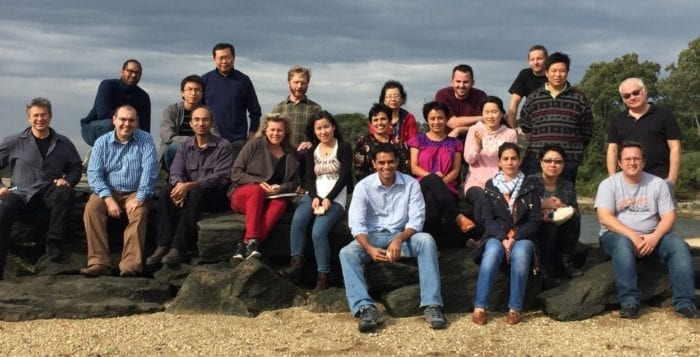CSHL’s Doreen Ware explores rice, sorghum genes

By Daniel Dunaief
In a two-month span, members of Doreen Ware’s lab at Cold Spring Harbor Laboratory have published three articles that address fundamental properties of plants.

Printed in the journal Nature Genetics, researchers in her lab studied the genes involved in conferring disease resistance across a range of species of rice. Another study, featured in Nature Communications, found the genes and the molecular pathway that determines the number of fertile flowers in the cereal crop sorghum.
In Frontiers in Plant Science, her productive team identified the causal genes that enable sorghum to develop a waxy outer layer that allows it to resist drought by containing water vapor.
“I am pleased with the recent publications from the laboratory,” Ware, who is also a computational biologist for the U. S. Department of Agriculture, explained in an email. “This is a sign of productivity, as well as the impact [technological] advances and drop in sequencing [costs] that is supporting these science advancements.”
Her lab is interested in the link between the genes in a plant and the way it develops.
“I want to understand mechanistically how the outputs in a genome interact with one another to produce a product,” Ware said. This will allow the lab to inform breeding models. “We would like to use the biological mechanism to support predictive modeling.”
In the rice article, Ware, informatics manager Joshua Stein at Cold Spring Harbor Laboratory and University of Arizona plant scientist Rod Wing searched for the specific genetic sequences different species of rice around the world use to develop resistance to infections by fungi, bacteria and other pathogens.
They used wild varieties of rice that had not been domesticated and looked for signals in the DNA. These were selected by their collaborators based on phenotypes that may be of value to introduce into domesticated varieties.
Stein looked at rice in areas including Asia, Africa, South America and Australia. Through this analysis, he was able to focus on specific genetic sequences that helped these species survive local threats.
As a first step, Stein explained, they have identified all of the genes in these species, but do not yet know which are important for local adaption. This article could provide information on the region of the genome that had disease genes that have been successful over time against threats in the environment.
One potential route to reducing dependency on pesticides is to introduce natural resistance or tolerance. By providing multiple ways of defending itself, a plant can reduce the chance that a pathogen can overcome all of these defenses.
“This is a similar strategy that is used to address both viral diseases and cancer treatment,” Ware explained.
Boosting the defenses of some of these crops with genes that have worked in the past is one strategy toward sustainability, although the scientists would need to work on the specifics to see how they were deployed.
Stein explained that his role in this specific study was to annotate the genes by using computer programs to look at DNA sequences. Stein used a process called comparative genomics, in which he studied the genes of numerous species of rice and compared them to look for similarities and differences.
“Because these different species grow in different climates and geographical ranges, they will be locally adapted to those regions,” Stein said. “Those genes might be important to improve cultivated rice.”
As climates change and people and materials such as seed crops move around the world, rice may need to develop a resistance to a bacteria or fungi it hasn’t encountered much through its history. Indeed, even those species of rice that haven’t moved to new areas may face threats from new challenges, such as insects, fungi, bacteria and viruses, that have moved into the area.
By understanding successful adaptive strategies, researchers like Ware and Stein can look for ways to transfer these defenses to other rice varieties.
Stein likens the process to an arms race that pits pathogens against food crops. “There are real examples of where a resistance gene has been transferred from a wild species to a cultivated species using traditional approaches,” he said. This includes knocking out specific genes in wheat that provide powdery mildew resistance.
Ware’s lab also produced an article in which they explored the genetic pathway that tripled the grain number of sorghum. The grain is produced on the panicle, which has many branches. In a normal plant, more than half of the flowers are not fertile, producing fewer grains.
“We have recently published a paper on a variety of sorghum where nearly all of the flowers are fertile, increasing the grain number on each head,” said Ware.
The work was led by Yinping Jiao and Young Koung Lee, postdoctoral researchers in Ware’s lab. Jiao focused on the computational analysis while Lee explored the development.
The researchers reduced the level of a hormone, which generated more flowers and more seeds. Other researchers could take a similar approach to boost yield in other grain crops.
Employing a commonly used technique to introduce new variation to support trait development, Department of Agriculture plant biologist Zhanguo Xin created a new variant that resulted in a change in a protein. This plant had a lower level of the hormone jasmonic acid in the developing flower. The researchers believe a reduction in the activity of a transcription factor that controls gene regulation caused this.
“We are currently exploring if this is associated with a direct or indirect interaction with biosynthetic genes required to make the plant hormone,” Ware said.
Early in January, Ware’s lab also produced a study in which they used mutations in sorghum to reveal the genetic mechanism that enables the plant to produce a wax that helps with its drought resistance.
Ware suggested these studies are linked to an underlying goal. “In human health, genomics and mechanism support the development of management of disease and in some cases cures,” she explained. “In agriculture, it leads to improved germplasm development and sustained agriculture.”






